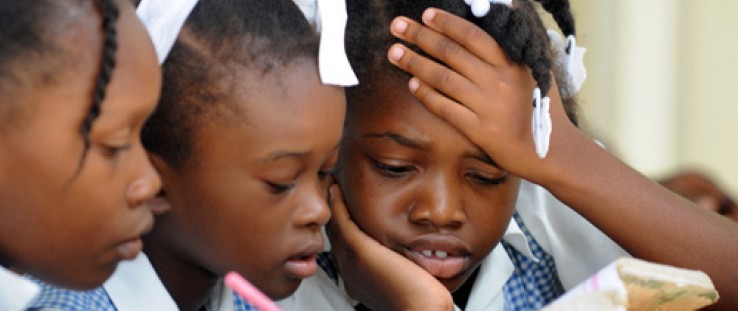 Schoolchildren concentrate at Ecole Marie Dominique Mazzarello in Port-au-Prince.
Kendra Helmer/USAID
Schoolchildren concentrate at Ecole Marie Dominique Mazzarello in Port-au-Prince.
Kendra Helmer/USAID
 Schoolchildren concentrate at Ecole Marie Dominique Mazzarello in Port-au-Prince.
Kendra Helmer/USAID
Schoolchildren concentrate at Ecole Marie Dominique Mazzarello in Port-au-Prince.
Kendra Helmer/USAID
A Haitian nun who goes by the name Sister Rose runs the L'Ecole Sacre Coeur, a girl's primary and secondary school located in Cap-Haïtien, a relatively large port town in northern Haiti. She speaks softly as she glides through an empty courtyard that will soon be filled with students.
"This year," she says, "we can teach more students. We used to have enough classrooms for 1,200 students, but now we have space for more than 1,300 students and an extra room for computers."
The expanded enrollment is due, in part, to a tin roof funded by USAID. The industrial-looking roof rests atop the second story of the school building. It covers two new classrooms and an additional room for the school's 12 donated computers. Parents pitched in to fund construction of the walls earlier this year, but the new section of the school sat roofless after Sister Rose ran out of funds.
"There was no money left," she said soberly. "I don't know how long it would have taken to find the money to finish the new section [of the school]."
With just a few days until the start of the school year in October, USAID's Office of Transition Initiatives (OTI) partnered with the municipality of Cap-Haïtien to provide the school with an in-kind grant to cover and furnish the roofless rooms and ensure it didn't go student-less.
Quick and Nimble
Small projects that make an immediate impact are OTI's bread and butter. The USAID office uses fast and flexible grants to target regions at risk of instability. In this case, OTI's partner, Development Alternatives Inc., contracted with local Haitians to do the work. OTI's quick-fire approach complements USAID's program funding for larger projects that often take more time as they require assessments to ensure long-term impact.
Haiti's education sector was bad before the Jan. 12, 2010, earthquake, and it's likely much worse a year later. Nine out of 10 schools in Haiti are private institutions according to the Inter-American Development Bank. Around half of Haitian children of appropriate age were not enrolled in primary school even before the earthquake, which damaged or destroyed 4,000 schools. USAID has helped the Haitian Ministry of Education build 56 semi-permanent schools, but there is still a long way to go.
Sister Rose intends to use the new rooms for more than students. She plans to invite adults who want to expand or hone their professional skills to do so at the school after hours.
"I can help the parents, too," she said. "I will teach market women the skills to run a business."
Cap-Haïtien was not directly affected by the earthquake, but many Haitians came to the port town after the disaster in search of shelter, jobs, and support from family members. The relatively few jobs that exist in Haiti—and the relatively large number of Haitians seeking them—are disproportionately located in the capital city of Port-au-Prince.
With its epicenter near Port-au-Prince, the earthquake destroyed many businesses and houses, eliminating jobs and homes in the surrounding area. Investments in Cap-Haïtien could open a new venue for Haitians looking to get back to work while decentralizing and diversifying the country's economy and population.
Hundreds of Backpacks
At a different school across town, hundreds of colorful backpacks filled with school supplies sat in stacks along a classroom wall, while hundreds more leaned against an adjacent wall waiting to be filled.
A group of effervescent mothers stuffed school supplies into the new backpacks as part of USAID's temporary employment program, often referred to by Haitians as cash-for-work. The smiling mothers and colorful backpacks contrasted with the old school's peeling paint and buckling floorboards.
With school starting in a few days, students needed notebooks, pencils, protractors, and other supplies. OTI and the municipality have also partnered to reinforce the school building to ensure the safety of the students.
At both Cap-Haïtien schools, USAID is working to boost Haiti's education sector while helping to stabilize potentially volatile communities and make them more attractive alternatives to living in Port-au-Prince. None of these tasks is easy and progress is slow, but the impact is already visible on the faces of Haitian mothers and children.







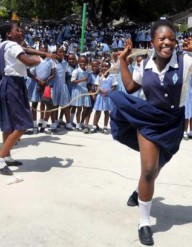

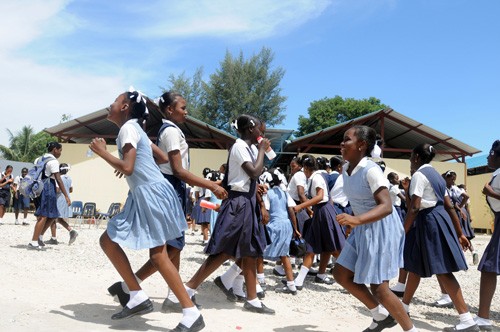
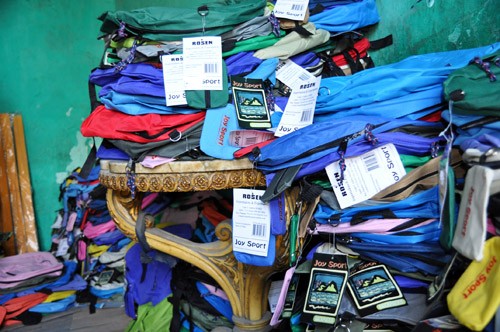
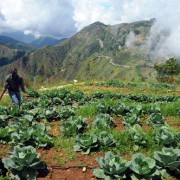
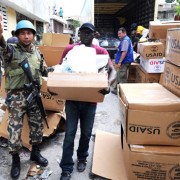
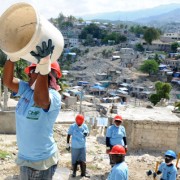
Comment
Make a general inquiry or suggest an improvement.